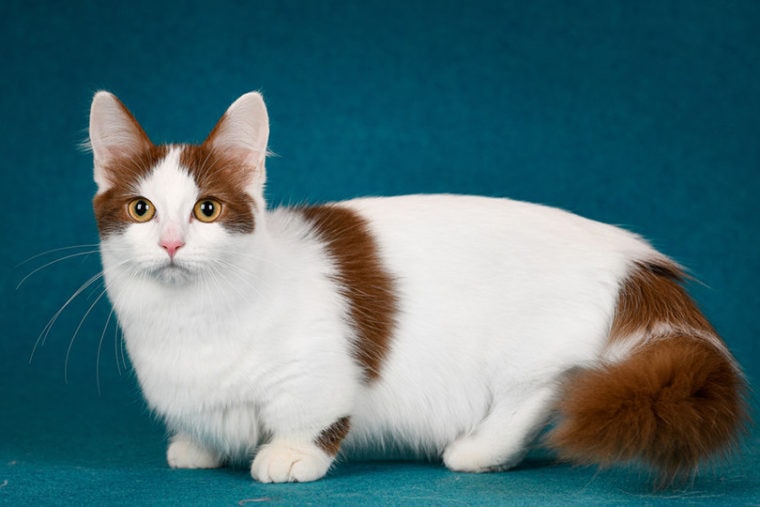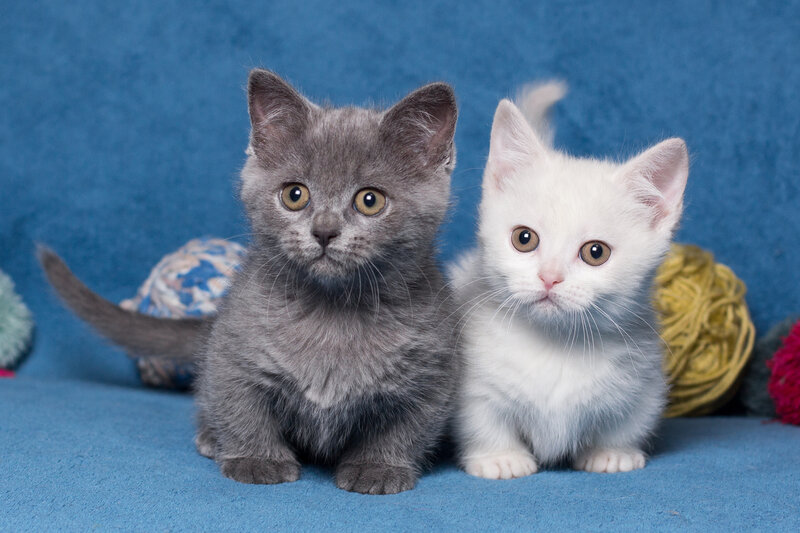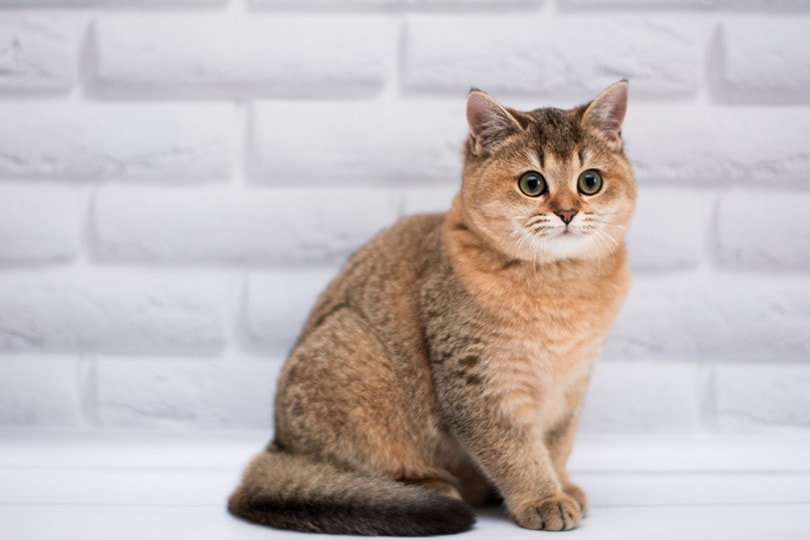
Munchkin cats are known for being smaller than other cat breeds, but are you wondering just how big your furry friend will grow? They grow to be 6–8 pounds and 5–8 inches. Understanding your Munchkin cat’s growth and weight can be a mystery to new owners of this breed. In this quick guide we’ll cover their growth stages from birth to adulthood and explain what to expect.
We’ll also provide you with a few essential tips on how to maintain your cat’s health and nutrition to ensure they reach their full potential size. So, whether you’re a new Munchkin cat owner or a seasoned pro, this guide has everything you need to know to help your Munchkin reach their maximum size and live a happy, healthy life.
Munchkin Cat Breed Overview
The Munchkin cat breed is a relatively new addition to the feline world, having been developed in the 1990s. These cats are known for their short legs, which are the result of a genetic mutation. While some people may find the appearance of these cats to be unusual, they’re beloved by many for their playful and affectionate personalities.
Munchkin cats come in a variety of colors and patterns, including calico, tabby, and solid colors like black or white. They have medium-sized bodies and round faces, with a relatively short tail. The breed is generally healthy and has an average lifespan of 12–15 years.
One of the key characteristics of Munchkin cats is their playfulness. They’re known for being energetic and curious, and they enjoy playing with toys and interacting with their owners. They’re also quite social and tend to get along well with other cats and even dogs.
Despite their short legs, Munchkin cats are quite agile and can jump and climb with ease. However, their short stature can make them more prone to certain health issues, such as back problems. It is important for owners to provide these cats with proper support and to avoid activities that could put too much strain on their backs.
Overall, though, the Munchkin cat breed is a unique and charming addition to the feline world. While they may not be for everyone, those who appreciate their playful personalities and distinctive appearance are sure to fall in love with these adorable cats.

Munchkin Cat Size and Growth Chart
| Age | Weight Range | Height Range |
| 3 months | 3–5 pounds | 4–5 inches |
| 6 months | 4–6 pounds | 4–6 inches |
| 9 months | 5–8 pounds | 4–6 inches |
| 12 months | 6–8 pounds | 5–8 inches |
When Does a Munchkin Cat Stop Growing?
Munchkin cats typically stop growing by the age of 2 years old. However, some cats may reach their full size earlier or later, depending on various factors. It’s essential to monitor your cat’s growth and development to ensure they’re healthy and developing as they should.
When to Be Concerned About Your Munchkin Cat’s Size
If you notice that your Munchkin cat isn’t growing or developing as they should, it’s essential to consult with your veterinarian. Signs that your cat may not be growing or developing properly include a lack of appetite, lethargy, and a failure to gain weight. Additionally, if you notice that your cat is significantly smaller or larger than average for their age and gender, it may indicate an underlying health condition that requires medical attention.

Factors Affecting the Size of Munchkin Cat
The size of a Munchkin cat is determined by genetics (i.e., it’s parents), nutrition, and lifestyle. Like with any animal, genetics play a major role in the size of a Munchkin cat. These cats are born with a genetic mutation that causes their legs to be quite shorter than normal in comparison to other felines. However, not all Munchkin cats have the same degree of shortness in their legs. The degree of shortness is determined by the genes passed on by their parents. So, if both parents have the gene for short legs, their offspring will likely have shorter legs as well. However, if only one parent has the gene, the kittens may have longer legs.
Nutrition is also an important factor in the size of a Munchkin cat. Proper nutrition is essential for the growth and development of all cats, and Munchkin cats are no exception. Feeding your Munchkin cat a well-balanced diet that is rich in nutrients can help ensure that they grow to their full potential. On the other hand, feeding your cat a poor diet can lead to stunted growth (even shorter legs) and other health problems.
And then there’s lifestyle, which can also slightly impact the size of a Munchkin cat. Cats that are kept in small spaces or are not given enough exercise may not grow to their full potential. Providing your Munchkin cat with plenty of space to run and play, as well as opportunities for exercise, can help ensure that they grow to their full size.
Health Issues That Can Affect Growth
Like any other breed, Munchkin cats are prone to certain health issues that can potentially affect their growth and development. One common health issue that can impact a Munchkin cat’s growth is obesity. Due to their small stature, Munchkin cats have a higher risk of becoming overweight, which can cause joint and mobility problems. So, monitoring their diet and ensuring that they’re receiving a balanced and appropriate amount of food is crucial to their development.
Another health concern for Munchkin cats is skeletal abnormalities, which can lead to growth and development issues. This can include conditions such as lordosis, a condition where the spine curves excessively, or pectus excavatum, where the chest appears sunken in.
Regular check-ups with a vet can help catch these issues early on and provide appropriate treatment. Additionally, dental health is important for all cats, and Munchkins are no exception. Poor dental health can lead to problems with eating and can impact overall health and growth. But providing regular dental care, such as brushing their teeth or offering dental treats, can help maintain good oral hygiene.

Ideal Diet for Maintaining a Healthy Weight
The ideal diet for maintaining a healthy weight for Munchkin cats includes high-quality protein, complex carbohydrates, and healthy fats. The protein should come from animal sources such as chicken or fish, while the carbohydrates should come from whole grains such as brown rice. Healthy fats such as omega-3 fatty acids can be found in fish oil or flaxseed oil.
It’s also important to ensure that your Munchkin is getting enough water to stay hydrated. Avoid feeding your cat table scraps or human food, as these can be high in calories and contribute to weight gain. Feeding your Munchkin smaller, more frequent meals throughout the day can also help with weight management. Regular exercise and playtime can also help keep your cat at a healthy weight.
Feeding your cat the right amount of calories is key to achieving the goal of maintaining a good weight and growing adequately over its first months of life. The number of calories your cat needs depends on a variety of factors, including their age, sex, activity level, and weight. As a general guideline, an average adult Munchkin cat will need between 200 and 300 calories per day and at least 26% of this should be protein – remember, cats are carnivores. Roughly 10% should be carbs and their fat intake should be no more than roughly 9% of their calories each day.
However, all of this can vary widely depending on your cat’s individual needs. But it can be helpful to consult with your veterinarian to determine the appropriate caloric intake for your Munchkin cat based on their specific situation.
How to Measure Your Munchkin Cat
Measuring and tracking your Munchkin cat’s size is crucial to ensure they’re growing and developing as they should. To measure your cat’s height, simply measure from the floor to the top of their shoulder blades. You can use a tape measure and place it near their nose and end it at the base of their tail. To measure their weight, use a scale designed for cats or weigh them at your vet’s office. You can also stand on a scale without and then with your cat to get their weight. Just subtract the total weight from your weight by yourself.
Conclusion
To sum things up, having some understanding of your Munchkin cat’s growth and weight chart is crucial to ensure they’re developing and growing as they should. By monitoring your cat’s height and weight, providing them with a balanced diet and plenty of opportunities for exercise, and consulting with a good vet if you have any concerns, you can help your furry friend reach their full potential size and live a happy, healthy life.
Related read:
- How High Can a Munchkin Cat Jump? Breed Facts & FAQs
- Will a Munchkin Cat Get Along With Dogs? Temperament & FAQs
Featured Image Credit: MDavidova, Shutterstock






